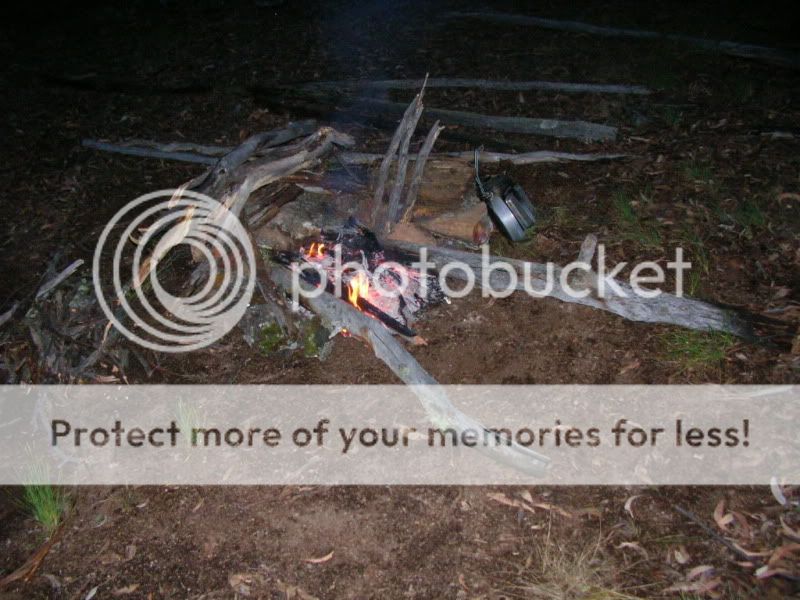OK here's a few more
Charcoal from the fire makes an effective scrubber for frypans & billys

Preparation is important before lighting the campfire. Kindling that is sorted into different thicknesses makes it so much easier to light a fire with wet wood without the need to split timber ..
..

Especially when used with this firelay

As seen here:
[video=youtube;gqW0lmj6lzA]http://www.youtube.com/watch?v=gqW0lmj6lzA[/video]
Kindling can be prepared without tools by simply propping up the wood on another log & stomping on it as seen here:
[video=youtube;928mnpV5M6E]http://www.youtube.com/watch?v=928mnpV5M6E[/video]
If you have access to a forked tree, then the leverage that can be generated can be used to break wood down to size without the use of tools as seen here:
[video=youtube;XQEgOwpDXhI]http://www.youtube.com/watch?v=XQEgOwpDXhI[/video]
If the wood doesn't easily yield to the previous technique, then the logs can be fed onto the fire as they burn

Wet wood can be dried by stacking it across the top of a fire.

And sausages that are taken bush can have their shelf life extended by a couple of days by hot smoking

An old cake cooling rack makes a very lightweight & effective campfire grill

A couple of simple tripods & a cross piece is a mutli tasking piece of gear. It can be used to get heavier logs off the ground to start drying, as well as making a usefull drying rack for clothes

A recycled wine bladder makes a very usefull & easily transported water container (especially the ones with a removable tap). Not only do you get the benefit of emptying the original , but it also works well as an "in camp" water container. Sitting it in the fork of a tree saves bending (important as you get older & lazier
, but it also works well as an "in camp" water container. Sitting it in the fork of a tree saves bending (important as you get older & lazier  )
)

A piece of bark at the end of a stick makes an effective tarp tensioner

Soap that is put into an old stocking not only gives you a soap container that you can hung up (saves bending over), but it also prevents "stuff" from sticking to the soap

Plastic produce bags (they weigh nothing & fold up very small) make a great waterproof seating that will stop your trousers from getting wet when you sit on wet wood

Hope this has helped .
.
Kind regards
Mick
Charcoal from the fire makes an effective scrubber for frypans & billys

Preparation is important before lighting the campfire. Kindling that is sorted into different thicknesses makes it so much easier to light a fire with wet wood without the need to split timber

Especially when used with this firelay

As seen here:
[video=youtube;gqW0lmj6lzA]http://www.youtube.com/watch?v=gqW0lmj6lzA[/video]
Kindling can be prepared without tools by simply propping up the wood on another log & stomping on it as seen here:
[video=youtube;928mnpV5M6E]http://www.youtube.com/watch?v=928mnpV5M6E[/video]
If you have access to a forked tree, then the leverage that can be generated can be used to break wood down to size without the use of tools as seen here:
[video=youtube;XQEgOwpDXhI]http://www.youtube.com/watch?v=XQEgOwpDXhI[/video]
If the wood doesn't easily yield to the previous technique, then the logs can be fed onto the fire as they burn


Wet wood can be dried by stacking it across the top of a fire.

And sausages that are taken bush can have their shelf life extended by a couple of days by hot smoking

An old cake cooling rack makes a very lightweight & effective campfire grill

A couple of simple tripods & a cross piece is a mutli tasking piece of gear. It can be used to get heavier logs off the ground to start drying, as well as making a usefull drying rack for clothes


A recycled wine bladder makes a very usefull & easily transported water container (especially the ones with a removable tap). Not only do you get the benefit of emptying the original
 )
)
A piece of bark at the end of a stick makes an effective tarp tensioner

Soap that is put into an old stocking not only gives you a soap container that you can hung up (saves bending over), but it also prevents "stuff" from sticking to the soap

Plastic produce bags (they weigh nothing & fold up very small) make a great waterproof seating that will stop your trousers from getting wet when you sit on wet wood


Hope this has helped
 .
.Kind regards
Mick
Last edited:




 Little bits of advice can have an inordinate effect.
Little bits of advice can have an inordinate effect.